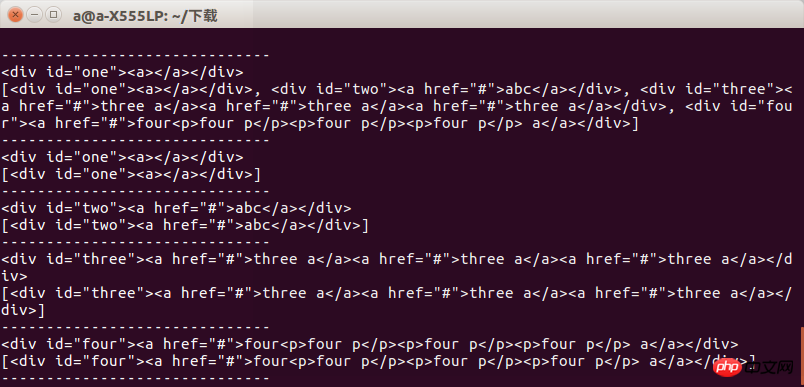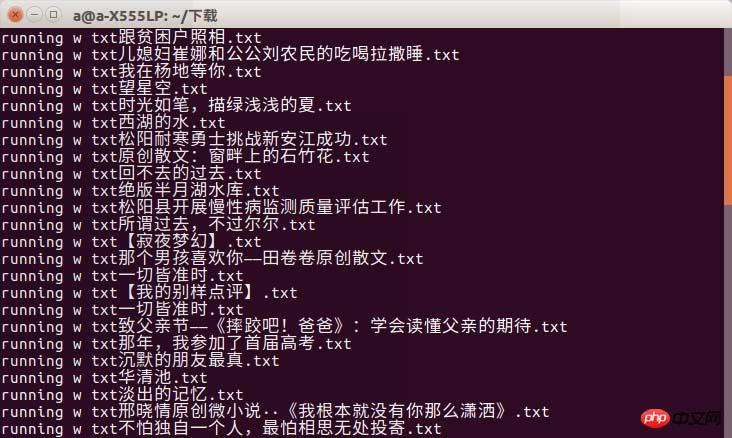Python 크롤링 기사 예제 튜토리얼
이 기사는 주로 Python을 사용하여 산문 웹사이트에서 기사를 크롤링하는 관련 정보를 소개합니다. 기사의 소개는 매우 자세하며 필요한 모든 사람을 위한 특정 참고 자료와 학습 가치가 있습니다.
이 기사는 주로 Python 크롤링 산문 네트워크 기사에 대한 관련 내용을 소개합니다. 자세한 소개를 살펴보겠습니다.
렌더링은 다음과 같습니다.

python 2.7 구성
bs4 requests
설치 pip를 사용하여 sudo pip install bs4 설치sudo pip install bs4
sudo pip install requests
简要说明一下bs4的使用因为是爬取网页 所以就介绍find 跟find_all
find跟find_all的不同在于返回的东西不同 find返回的是匹配到的第一个标签及标签里的内容
find_all返回的是一个列表
比如我们写一个test.html 用来测试find跟find_all的区别。
内容是:
<html> <head> </head> <body> <p id="one"><a></a></p> <p id="two"><a href="#" rel="external nofollow" rel="external nofollow" rel="external nofollow" rel="external nofollow" rel="external nofollow" >abc</a></p> <p id="three"><a href="#" rel="external nofollow" rel="external nofollow" rel="external nofollow" rel="external nofollow" rel="external nofollow" >three a</a><a href="#" rel="external nofollow" rel="external nofollow" rel="external nofollow" rel="external nofollow" rel="external nofollow" >three a</a><a href="#" rel="external nofollow" rel="external nofollow" rel="external nofollow" rel="external nofollow" rel="external nofollow" >three a</a></p> <p id="four"><a href="#" rel="external nofollow" rel="external nofollow" rel="external nofollow" rel="external nofollow" rel="external nofollow" >four<p>four p</p><p>four p</p><p>four p</p> a</a></p> </body> </html>
然后test.py的代码为:
from bs4 import BeautifulSoup import lxml if __name__=='__main__': s = BeautifulSoup(open('test.html'),'lxml') print s.prettify() print "------------------------------" print s.find('p') print s.find_all('p') print "------------------------------" print s.find('p',id='one') print s.find_all('p',id='one') print "------------------------------" print s.find('p',id="two") print s.find_all('p',id="two") print "------------------------------" print s.find('p',id="three") print s.find_all('p',id="three") print "------------------------------" print s.find('p',id="four") print s.find_all('p',id="four") print "------------------------------"
运行以后我们可以看到结果当获取指定标签时候两者区别不大当获取一组标签的时候两者的区别就会显示出来

所以我们在使用时候要注意到底要的是什么,否则会出现报错
接下来就是通过requests 获取网页信息了,我不太懂别人为什么要写heard跟其他的东西
我直接进行网页访问,通过get方式获取散文网几个分类的二级网页然后通过一个组的测试,把所有的网页爬取一遍
def get_html():
url = "https://www.sanwen.net/"
two_html = ['sanwen','shige','zawen','suibi','rizhi','novel']
for doc in two_html:
i=1
if doc=='sanwen':
print "running sanwen -----------------------------"
if doc=='shige':
print "running shige ------------------------------"
if doc=='zawen':
print 'running zawen -------------------------------'
if doc=='suibi':
print 'running suibi -------------------------------'
if doc=='rizhi':
print 'running ruzhi -------------------------------'
if doc=='nove':
print 'running xiaoxiaoshuo -------------------------'
while(i<10):
par = {'p':i}
res = requests.get(url+doc+'/',params=par)
if res.status_code==200:
soup(res.text)
i+=i这部分的代码中我没有对res.status_code
def soup(html_text): s = BeautifulSoup(html_text,'lxml') link = s.find('p',class_='categorylist').find_all('li') for i in link: if i!=s.find('li',class_='page'): title = i.find_all('a')[1] author = i.find_all('a')[2].text url = title.attrs['href'] sign = re.compile(r'(//)|/') match = sign.search(title.text) file_name = title.text if match: file_name = sign.sub('a',str(title.text))
bs4 사용에 대한 간략한 설명입니다. find_all
find와 find_all의 차이점은 반환되는 내용이 다르다는 것입니다. find는 일치하는 첫 번째 태그를 반환하고 태그의 내용은
find_all이 목록을 반환합니다
def get_content(url): res = requests.get('https://www.sanwen.net'+url) if res.status_code==200: soup = BeautifulSoup(res.text,'lxml') contents = soup.find('p',class_='content').find_all('p') content = '' for i in contents: content+=i.text+'\n' return content
test.py의 코드는
f = open(file_name+'.txt','w') print 'running w txt'+file_name+'.txt' f.write(title.text+'\n') f.write(author+'\n') content=get_content(url) f.write(content) f.close()
실행 후 지정된 태그를 가져오면 결과를 볼 수 있습니다. 두 태그를 가져오면 두 태그의 차이점이 표시됩니다

그래서 사용할 때 필요한 것에 주의를 기울여야 합니다. 그렇지 않으면 오류가 발생합니다
 다음 단계는 요청을 통해 웹페이지 정보를 얻는 것입니다. 다른 사람들이 왜 들었는지 그리고 다른 것들을 쓰는지 잘 이해합니다
다음 단계는 요청을 통해 웹페이지 정보를 얻는 것입니다. 다른 사람들이 왜 들었는지 그리고 다른 것들을 쓰는지 잘 이해합니다
직접 진행하겠습니다. 웹 페이지 액세스의 경우 get 메소드를 사용하여 prose.com에서 여러 카테고리의 보조 웹 페이지를 얻은 다음 그룹 테스트를 통과하여 모든 웹 페이지를 크롤링합니다
🎜🎜🎜f = open(file_name+'.txt','w') print 'running w txt'+file_name+'.txt' f.write(title.text+'\n') f.write(author+'\n') content=get_content(url) f.write(content) f.close()
res.status_code를 수정하지 않았습니다. 200이 아닌 경우 오류가 표시되지 않고 크롤링된 콘텐츠가 손실된다는 문제가 있습니다. 그러다가 Sanwen.net/rizhi/&p=1🎜🎜🎜웹페이지를 분석했는데 p의 최대값은 10입니다. 이해가 안 되네요. 지난번에 디스크를 크롤링했을 때 100페이지였네요. 나중에요. 그런 다음 get 메소드를 통해 각 페이지의 내용을 가져옵니다. 🎜🎜🎜각 페이지의 내용을 가져온 후 작성자와 제목을 분석합니다. 🎜🎜🎜🎜rrreee🎜 제목을 가져올 때 문제가 있습니다. 글을 쓸 때 제목에 슬래시를 추가하는 이유는 무엇입니까? 한개도 아니고 2개가 더 있습니다. 나중에 파일을 작성할 때 이 문제로 인해 파일명이 틀리게 되어 정규식을 작성해 드렸습니다. 🎜🎜🎜마지막 단계는 각 페이지 분석을 통해 글 주소를 얻은 뒤, 원래는 웹페이지 주소를 변경해서 하나씩 직접 얻고 싶었는데, 문제를 해결합니다. 🎜🎜🎜🎜rrreee🎜마지막으로 파일을 작성하고 저장하면 ok🎜🎜🎜🎜rrreee🎜산문 네트워크에서 산문을 가져오는 기능이 3가지인데, 문제는 제가 모른다는 것입니다. 왜 일부 산문이 손실되었는지. 기사는 400개 정도만 얻을 수 있습니다. 이 기사는 Prose.com의 기사와 많이 다르지만 실제로는 페이지 단위로 얻을 수 있습니다. 물론 웹 페이지를 접속할 수 없게 만들어야 할 것 같아요🎜🎜🎜🎜rrreee🎜렌더링을 깜빡할 뻔했어요🎜🎜🎜🎜🎜🎜타임아웃 현상이 생길 수도 있겠네요. .. 대학에 가면 반드시 일어날 것이라고 말할 수 있습니다. 좋은 네트워크를 선택하십시오! 🎜위 내용은 Python 크롤링 기사 예제 튜토리얼의 상세 내용입니다. 자세한 내용은 PHP 중국어 웹사이트의 기타 관련 기사를 참조하세요!

핫 AI 도구

Undresser.AI Undress
사실적인 누드 사진을 만들기 위한 AI 기반 앱

AI Clothes Remover
사진에서 옷을 제거하는 온라인 AI 도구입니다.

Undress AI Tool
무료로 이미지를 벗다

Clothoff.io
AI 옷 제거제

AI Hentai Generator
AI Hentai를 무료로 생성하십시오.

인기 기사

뜨거운 도구

메모장++7.3.1
사용하기 쉬운 무료 코드 편집기

SublimeText3 중국어 버전
중국어 버전, 사용하기 매우 쉽습니다.

스튜디오 13.0.1 보내기
강력한 PHP 통합 개발 환경

드림위버 CS6
시각적 웹 개발 도구

SublimeText3 Mac 버전
신 수준의 코드 편집 소프트웨어(SublimeText3)

뜨거운 주제
 7488
7488
 15
15
 1377
1377
 52
52
 77
77
 11
11
 51
51
 19
19
 19
19
 40
40
 MySQL은 지불해야합니다
Apr 08, 2025 pm 05:36 PM
MySQL은 지불해야합니다
Apr 08, 2025 pm 05:36 PM
MySQL에는 무료 커뮤니티 버전과 유료 엔터프라이즈 버전이 있습니다. 커뮤니티 버전은 무료로 사용 및 수정할 수 있지만 지원은 제한되어 있으며 안정성이 낮은 응용 프로그램에 적합하며 기술 기능이 강합니다. Enterprise Edition은 안정적이고 신뢰할 수있는 고성능 데이터베이스가 필요하고 지원 비용을 기꺼이 지불하는 응용 프로그램에 대한 포괄적 인 상업적 지원을 제공합니다. 버전을 선택할 때 고려 된 요소에는 응용 프로그램 중요도, 예산 책정 및 기술 기술이 포함됩니다. 완벽한 옵션은없고 가장 적합한 옵션 만 있으므로 특정 상황에 따라 신중하게 선택해야합니다.
 설치 후 MySQL을 사용하는 방법
Apr 08, 2025 am 11:48 AM
설치 후 MySQL을 사용하는 방법
Apr 08, 2025 am 11:48 AM
이 기사는 MySQL 데이터베이스의 작동을 소개합니다. 먼저 MySQLworkBench 또는 명령 줄 클라이언트와 같은 MySQL 클라이언트를 설치해야합니다. 1. MySQL-Uroot-P 명령을 사용하여 서버에 연결하고 루트 계정 암호로 로그인하십시오. 2. CreateABase를 사용하여 데이터베이스를 작성하고 데이터베이스를 선택하십시오. 3. CreateTable을 사용하여 테이블을 만들고 필드 및 데이터 유형을 정의하십시오. 4. InsertInto를 사용하여 데이터를 삽입하고 데이터를 쿼리하고 업데이트를 통해 데이터를 업데이트하고 DELETE를 통해 데이터를 삭제하십시오. 이러한 단계를 마스터하고 일반적인 문제를 처리하는 법을 배우고 데이터베이스 성능을 최적화하면 MySQL을 효율적으로 사용할 수 있습니다.
 MySQL은 인터넷이 필요합니까?
Apr 08, 2025 pm 02:18 PM
MySQL은 인터넷이 필요합니까?
Apr 08, 2025 pm 02:18 PM
MySQL은 기본 데이터 저장 및 관리를위한 네트워크 연결없이 실행할 수 있습니다. 그러나 다른 시스템과의 상호 작용, 원격 액세스 또는 복제 및 클러스터링과 같은 고급 기능을 사용하려면 네트워크 연결이 필요합니다. 또한 보안 측정 (예 : 방화벽), 성능 최적화 (올바른 네트워크 연결 선택) 및 데이터 백업은 인터넷에 연결하는 데 중요합니다.
 고로드 애플리케이션의 MySQL 성능을 최적화하는 방법은 무엇입니까?
Apr 08, 2025 pm 06:03 PM
고로드 애플리케이션의 MySQL 성능을 최적화하는 방법은 무엇입니까?
Apr 08, 2025 pm 06:03 PM
MySQL 데이터베이스 성능 최적화 안내서 리소스 집약적 응용 프로그램에서 MySQL 데이터베이스는 중요한 역할을 수행하며 대규모 트랜잭션 관리를 담당합니다. 그러나 응용 프로그램 규모가 확장됨에 따라 데이터베이스 성능 병목 현상은 종종 제약이됩니다. 이 기사는 일련의 효과적인 MySQL 성능 최적화 전략을 탐색하여 응용 프로그램이 고 부하에서 효율적이고 반응이 유지되도록합니다. 실제 사례를 결합하여 인덱싱, 쿼리 최적화, 데이터베이스 설계 및 캐싱과 같은 심층적 인 주요 기술을 설명합니다. 1. 데이터베이스 아키텍처 설계 및 최적화 된 데이터베이스 아키텍처는 MySQL 성능 최적화의 초석입니다. 몇 가지 핵심 원칙은 다음과 같습니다. 올바른 데이터 유형을 선택하고 요구 사항을 충족하는 가장 작은 데이터 유형을 선택하면 저장 공간을 절약 할 수있을뿐만 아니라 데이터 처리 속도를 향상시킬 수 있습니다.
 hadidb : 파이썬의 가볍고 수평 확장 가능한 데이터베이스
Apr 08, 2025 pm 06:12 PM
hadidb : 파이썬의 가볍고 수평 확장 가능한 데이터베이스
Apr 08, 2025 pm 06:12 PM
HADIDB : 가볍고 높은 수준의 확장 가능한 Python 데이터베이스 HadIDB (HADIDB)는 파이썬으로 작성된 경량 데이터베이스이며 확장 수준이 높습니다. PIP 설치를 사용하여 HADIDB 설치 : PIPINSTALLHADIDB 사용자 관리 사용자 만들기 사용자 : createUser () 메소드를 작성하여 새 사용자를 만듭니다. Authentication () 메소드는 사용자의 신원을 인증합니다. Fromhadidb.operationimportuseruser_obj = user ( "admin", "admin") user_obj.
 MongoDB 데이터베이스 비밀번호를 보는 Navicat의 방법
Apr 08, 2025 pm 09:39 PM
MongoDB 데이터베이스 비밀번호를 보는 Navicat의 방법
Apr 08, 2025 pm 09:39 PM
해시 값으로 저장되기 때문에 MongoDB 비밀번호를 Navicat을 통해 직접 보는 것은 불가능합니다. 분실 된 비밀번호 검색 방법 : 1. 비밀번호 재설정; 2. 구성 파일 확인 (해시 값이 포함될 수 있음); 3. 코드를 점검하십시오 (암호 하드 코드 메일).
 MySQL Workbench가 Mariadb에 연결할 수 있습니다
Apr 08, 2025 pm 02:33 PM
MySQL Workbench가 Mariadb에 연결할 수 있습니다
Apr 08, 2025 pm 02:33 PM
MySQL Workbench는 구성이 올바른 경우 MariadB에 연결할 수 있습니다. 먼저 커넥터 유형으로 "mariadb"를 선택하십시오. 연결 구성에서 호스트, 포트, 사용자, 비밀번호 및 데이터베이스를 올바르게 설정하십시오. 연결을 테스트 할 때는 마리아드 브 서비스가 시작되었는지, 사용자 이름과 비밀번호가 올바른지, 포트 번호가 올바른지, 방화벽이 연결을 허용하는지 및 데이터베이스가 존재하는지 여부를 확인하십시오. 고급 사용에서 연결 풀링 기술을 사용하여 성능을 최적화하십시오. 일반적인 오류에는 불충분 한 권한, 네트워크 연결 문제 등이 포함됩니다. 오류를 디버깅 할 때 오류 정보를 신중하게 분석하고 디버깅 도구를 사용하십시오. 네트워크 구성을 최적화하면 성능이 향상 될 수 있습니다
 MySQL에는 서버가 필요합니까?
Apr 08, 2025 pm 02:12 PM
MySQL에는 서버가 필요합니까?
Apr 08, 2025 pm 02:12 PM
생산 환경의 경우 성능, 신뢰성, 보안 및 확장 성을 포함한 이유로 서버는 일반적으로 MySQL을 실행해야합니다. 서버에는 일반적으로보다 강력한 하드웨어, 중복 구성 및 엄격한 보안 조치가 있습니다. 소규모 저하 애플리케이션의 경우 MySQL이 로컬 컴퓨터에서 실행할 수 있지만 자원 소비, 보안 위험 및 유지 보수 비용은 신중하게 고려되어야합니다. 신뢰성과 보안을 높이려면 MySQL을 클라우드 또는 기타 서버에 배포해야합니다. 적절한 서버 구성을 선택하려면 응용 프로그램 부하 및 데이터 볼륨을 기반으로 평가가 필요합니다.




